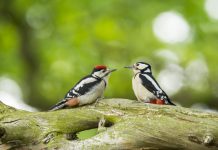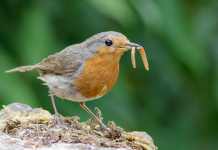Brrr! Is it just us or is it starting to get cold outside?
When it’s chilly, we wrap up warm, knock up the thermostat and put the kettle on for a nice cup of tea. But what do our feathered friends do?
Of course, wild birds have developed ways and means to deal with the chilly weather, but it can still be a very difficult time for them. Here’s why…
Why do birds need help when it’s cold?
With the destruction of natural habitats, comes a reduction in the amount of naturally occurring food sources, and this is why we suggest feeding birds all year round.
The problem in the winter however is that snow, ice and cold temperatures can make those insects, grubs and other creepy crawlies even harder to come by. Because of this, garden birds have more and more come to rely on us, for their niger, sunflower hearts and peanuts.
Many birds may be able to find their own food during the winter months, however water is a different beast altogether. Wild garden birds need water, but when the mercury drops really low, water of course freezes, and that really isn’t good for our feathered visitors. That’s why it is a great idea to put a bird bath in your garden, to increase supply, for both drinking and bathing.
What can I do to help garden birds in cold weather?

Image source: Thinkstock
There are all sorts of things you can do to keep the blue tits, finches and warblers happy. Here are some basic tips.
-
- Mornings are an important time for birds in the winter, as they look to recover the energy they lost in the night. So try and get up early to fill any feeders.
- Always make sure any supply of water is in a liquid state. Never use an antifreeze based product to defrost bird baths as this can poison birds.
- Consider putting up a nesting box to give smaller birds a roost site. If you install one at the start of the winter, it will still be used for breeding later on.
- Monitoring is also very important. Getting involved with events such as the Big Garden Birdwatch is great on a grander scale, but keep an eye on the numbers in your garden. If something changes radically, you may have to change what you are doing.
Should I put out any specific types of feed?
It’s all about energy! A high calorie seed mix on a bird table will turn your garden into a truly inviting pitstop for birds. Straight bird foods are also important, with sunflower seeds and peanuts being very calorific; which is just what those chilly little blighters need.
Suet and fat bars, whether hung up or put on a bird table, also offer a lot in terms of both nutrition and energy, but you’ll be surprised what you can find in your very own kitchen.
Leftovers, such as apples and pears will really help members of the thrush family, such as blackbirds. Meanwhile, pastry will be loved by birds of many varieties. Who knows, you may even see a crow creating a little cache of your leftover shortcrust, ready for when another cold snap comes.
Before you go…
According to the BTO, its no wonder bluetits need a helping hand!






















